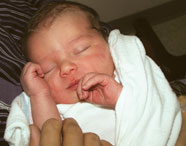
Pregnany pains helped by CST.
I was experiencing reflux in my 4th month of pregnancy, and this work really reduced it. In my last trimester, it helped me release tensions in my chest and pelvis. What really surprised me is how it helped me drop so much of the stressful stuff I can get so involved in.
Pamela Warshay, Owner of Sage Fitness
Craniosacral East is now working with more infants.

Birth can often be a riveting experience for a child's head and body. Craniosacral Therapy with its exceptionally gentle touch can help an infant afterward.
 Notice how this infant skull (veiwed from above), shows how much space there is between the bones. Most of the bones in our adult cranium are still in sections as an infant and child. For example the frontal bone which makes up our forehead is in 2 sections in an infant head. They will fully fuse into one bone within an infant's first year. Some bones are in four sections like our Temporal bones (where your ear comes out and jaw attaches). This bone takes 3 years to ossify, while others, like the Sacrum (the bottom of your spine at your pelvis) doesn't totally ossify until an adult's 20's!
Notice how this infant skull (veiwed from above), shows how much space there is between the bones. Most of the bones in our adult cranium are still in sections as an infant and child. For example the frontal bone which makes up our forehead is in 2 sections in an infant head. They will fully fuse into one bone within an infant's first year. Some bones are in four sections like our Temporal bones (where your ear comes out and jaw attaches). This bone takes 3 years to ossify, while others, like the Sacrum (the bottom of your spine at your pelvis) doesn't totally ossify until an adult's 20's!
During delivery these bone sections naturally glide over each other to allow the infant to get through the birth canal. This is also why infants are delivered with cone shaped heads. Sometimes, however, cranial bones glide over each other and then get partially stuck. This can happen more often If medical interventions were used to help the infant such as:
- Vacuum delivery
- C section
- Forceps
- Face-up delivery (sunny-side up)
- Breach delivery
- or a very long delivery where the infant may have been compressed for a while in one position.
Craniosacral Therapy is an ideal, gentle modality to help an infant's cranium recover from a difficult delivery. Our touch is often lighter than the weight of a nickel when working on an adults, and even less for children and infants. Craniosacral Therapy is so effective because it facilitates to flow of a child's own spinal fluid throughout their spine and head. It's their own energetic and fluid movement that creates the change--our touch is only a gentle and specific facilitator.
Improving an infant's ability to breastfeed is one of the most important results of Craniosacral Therapy for infants. If an infant is only feeeding at 50% of their optimum amount, it significantly impacts their growth. Not only is breastfeeding important physiologically, it also has tremendous emotional benefits. Anything we can do that can help a child nurse until a natural weening is in great benefit to them.
There is a particular bone in an infant's head that plays a role in suckling. The Vomer bone as (you can see below in pink in the image) naturally rocks back and forth on the bone above it, the Sphenoid. The vomer bone is right over the roof of the mouth, down the middle (right behind the nose). If an infant's vomer is partially restricted or impacted against the Sphenoid during delivery, this rocking motion can be reduced considerably. Interestingly, nature has its own way of addressing this common restriction: a child's relentless thumb sucking.
 This is the Vomer bone in pink in an adult head. The eyes and face would be facing left, and you can see the teeth for orientation. It is easy to see how this bone could get impacted during delivery and also easy to see how a child's suckling motion would require this bone to rock back and forth easily.
This is the Vomer bone in pink in an adult head. The eyes and face would be facing left, and you can see the teeth for orientation. It is easy to see how this bone could get impacted during delivery and also easy to see how a child's suckling motion would require this bone to rock back and forth easily.
Often times, Craniosacral Therapy can help release this bone and improve a child's ability to suckle.
Lastly, two issues affecting breastfeeding that will be covered in an upcoming blog will be:
- Craniosacral Therapy can help a mother's ability to attune to her infant's energy and needs. By helping mother's to return to their own centered, inner balance, it can better help them be available to their child.
- Craniosacral Therapy can help a child with reflux find a greater ease through their diaphragm and esophagus allowing food to naturally stay in the stomach.
The following excellent write up on Craniosacral Therapy by Laleche League (an association on breastfeeding) expands upon many of the points made here. For more info click here.
For more information about: Craniosacral East and our work with mothers, infants and children click right here.

